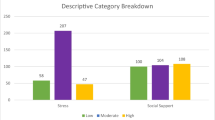Abstract
This study examined the relationships among early adolescent social coping behavior and measures of subjective well-being, specifically global life satisfaction and friend satisfaction. A total of 1,011 students in grades 7–8 at a southeastern US middle school completed measures of global life satisfaction, friend satisfaction and coping, on two occasions, 5 months apart. Social support seeking coping behavior at Time 1, but not problem-solving, distancing, internalizing or externalizing coping behaviors at Time 1, uniquely predicted global life satisfaction and friend satisfaction at Time 2. Implications for research and promoting adolescent well-being are discussed.

Similar content being viewed by others
References
Antaramian, S. P., Huebner, E. S., Hills, K. J., & Valois, R. F. (2010). A dual-factor model of mental health: Toward a more comprehensive understanding of youth functioning. American Journal of Orthopsychiatry, 80, 462–472.
Antaramian, S. P., Huebner, E. S., & Valois, R. F. (2008). Adolescent life satisfaction. Applied Psychology: An International Review, 57, 112–126.
Asher, S. R., Hymel, S., & Renshaw, P. D. (1984). Loneliness in children. Child Development, 55, 1456–1464.
Causey, D. L., & Dubow, E. F. (1992). Development of a self-report coping measure for elementary school children. Journal of Clinical Child Psychology, 21, 47–59.
Compas, B. E., Connor-Smith, J. K., Saltzman, H., Thomsen, A. H., & Wadsworth, M. E. (2001). Coping with stress during childhood and adolescence: Problems, progress, and potential in theory and research. Psychological Bulletin, 127, 87–127.
Davey, A., Savla, J., & Luo, Z. (2005). Issues in evaluating model fit with missing data. Structural Equation Modeling, 12, 578–597.
Davidson, M., Boland, E. A., & Grey, M. (1997). Teaching teens to cope: Coping skills training for adolescents with insulin-dependent diabetes mellitus. Journal of the Society of Pediatric Nurses, 2, 65–72.
Ebata, A. T., & Moos, R. H. (1994). Personal, situational, and contextual correlates of coping in adolescence. Journal of Research on Adolescence, 4, 99–125.
Fernando, S. (2008). The relationship between coping strategies and levels of life satisfaction in adolescents. (Unpublished masters thesis). University of South Carolina: Columbia, SC.
Gilman, R., & Huebner, E. S. (1997). Children’s reports of their life satisfaction: Convergence across raters, time and response formats. School Psychology International, 18, 229–243.
Helsen, M., Vollebergh, W., & Meeus, W. (2000). Social support from parents and friends and emotional problems in adolescence. Journal of Youth and Adolescence, 29, 319–335.
Hoyle, R. H. (1995). Structural equation modeling: Concepts, issues, and applications. Thousand Oaks, CA: Sage.
Hu, L., & Bentler, P. M. (1999). Cutoff criteria for covariance structure analysis: Conventional Criteria vs, new alternatives. Structural Equation Modeling, 6, 1–55.
Huebner, E. S. (1991). Initial development of the Students’ Life Satisfaction Scale. School Psychology International, 12, 231–240.
Huebner, E. S. (1994). Preliminary development and validation of a multidimensional life satisfaction scale for children. Psychological Assessment, 6, 149–158.
Huebner, E. S. (2004). Research on assessment of life satisfaction of children and adolescents. Social Indicators Research, 66, 3–33.
Huebner, E. S., & Gilman, R. (2002). An introduction to the Multidimensional Students’ Life Satisfaction Scale. Social Indicators Research, 60, 115–122.
Kline, R. B. (2005). Principles and practice of structural equation modeling. New York, NY: Guilford Press.
Kraag, G., Zeegers, M. P., Kok, G., Hosman, C., & Abu-Saad, H. H. (2006). School programs targeting stress management in children and adolescents: A meta-analysis. Journal of School Psychology, 44, 449–472.
Lazarus, R. S., & Folkman, S. (1987). Transactional theory and research on emotions and coping. European Journal of Personality, 1, 141–169.
Lent, R. W. (2004). Toward a unifying theoretical and practical perspective on well-being and psychosocial adjustment. Journal of Counseling Psychology, 51, 482–509.
Lewis, R., & Frydenberg, E. (2004). Thriving, surviving, or going under: Coping with everyday lives. Greenwich: Information Age Publishing.
Lyubormirsky, S., King, L. A., & Diener, E. (2005). The benefits of frequent positive affect: Does happiness lead to success? Psychological Bulletin, 131, 803–855.
Pavot, W., & Diener, E. (1993). Review of the satisfaction with life scale. Psychological Assessment, 5, 164–172.
Proctor, C., Linley, P. A., & Maltby, J. (2009). Youth life satisfaction measures: A review. The Journal of Positive Psychology, 4, 128–144.
Skinner, E. A., & Zimmer-Gembeck, M. J. (2007). The development of coping. Annual Review of Psychology, 58, 119–144.
Suldo, S. M., & Huebner, E. S. (2004). The role of life satisfaction in the relationship between authoritative parenting dimensions and adolescent problem behavior. Social Indicators Research, 66, 165–195.
Suldo, S. M., & Shaffer, E. J. (2008). Looking beyond psychopathology: The dual-factor model of mental health in youth. School Psychology Review, 37, 52–68.
Suldo, S. M., Shaunessy, E., & Hardesty, R. (2008). Relationships among stress, coping, and mental health in high-achieving high school students. Psychology in the Schools, 45, 273–290.
Terry, T., & Huebner, E. S. (1995). The relationship between self-concept and life satisfaction in children. Social Indicators Research, 35, 39–52.
Tucker, L. R., & Lewis, C. (1973). A reliability coefficient for maximum likelihood factor analysis. Psychometrika, 38, 1–10.
Weston, R., Gore, P. A., Chan, F., & Catalano, D. (2008). An introduction to using structural equation models in rehabilitation psychology. Rehabilitation Psychology, 53, 340–356.
Author information
Authors and Affiliations
Corresponding author
Rights and permissions
About this article
Cite this article
Saha, R., Huebner, E.S., Hills, K.J. et al. Social Coping and Life Satisfaction in Adolescents. Soc Indic Res 115, 241–252 (2014). https://doi.org/10.1007/s11205-012-0217-3
Accepted:
Published:
Issue Date:
DOI: https://doi.org/10.1007/s11205-012-0217-3




